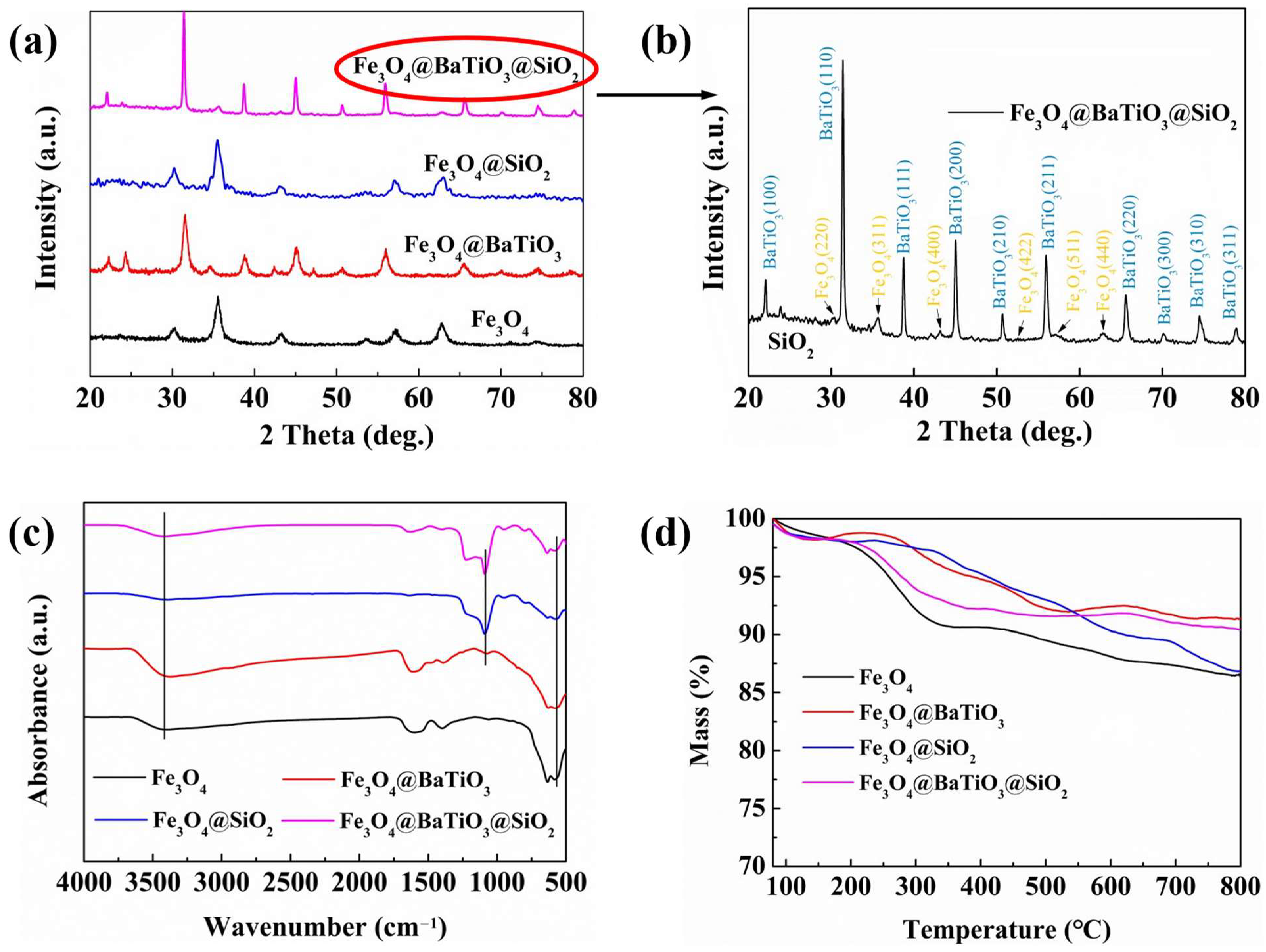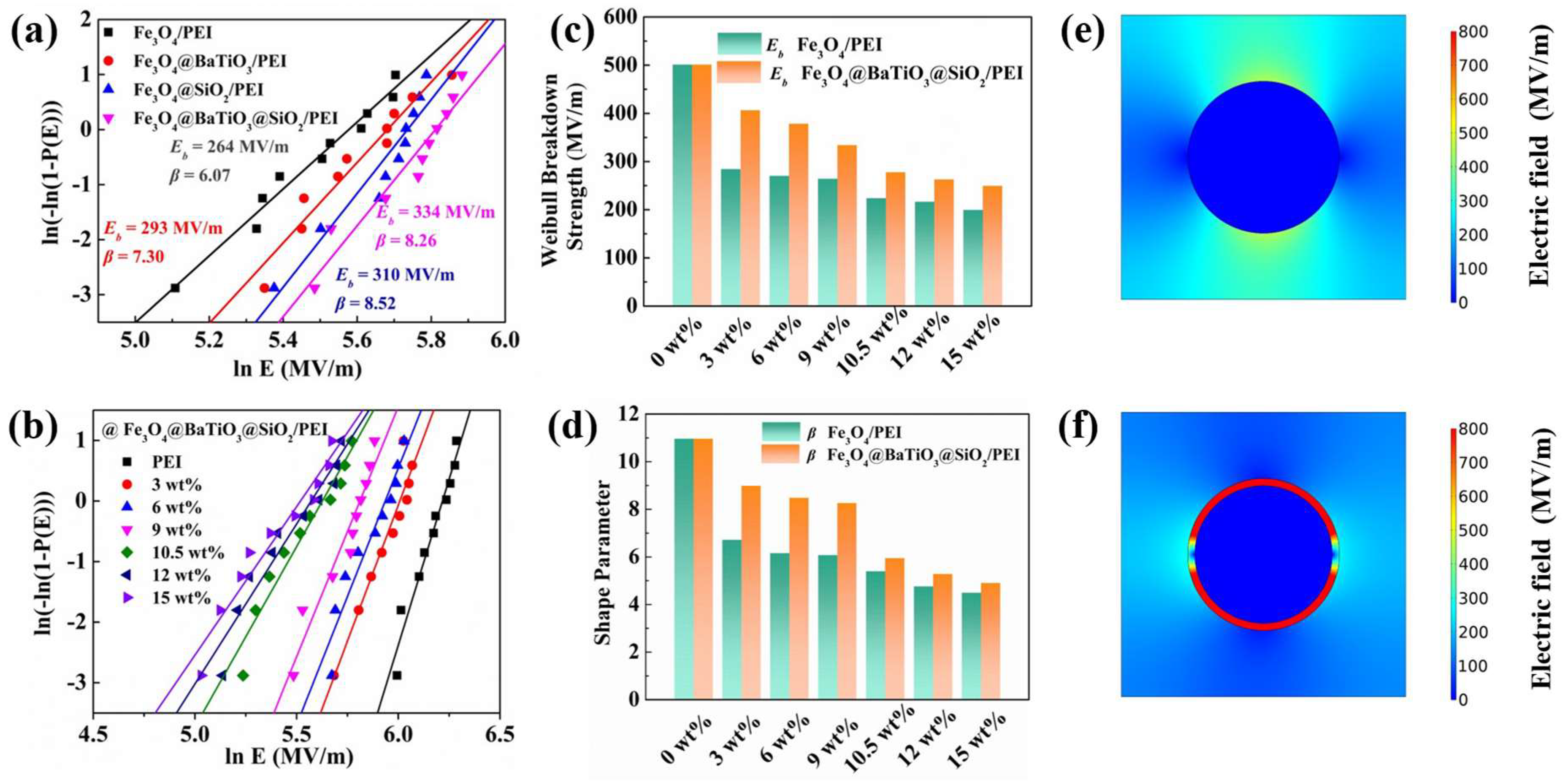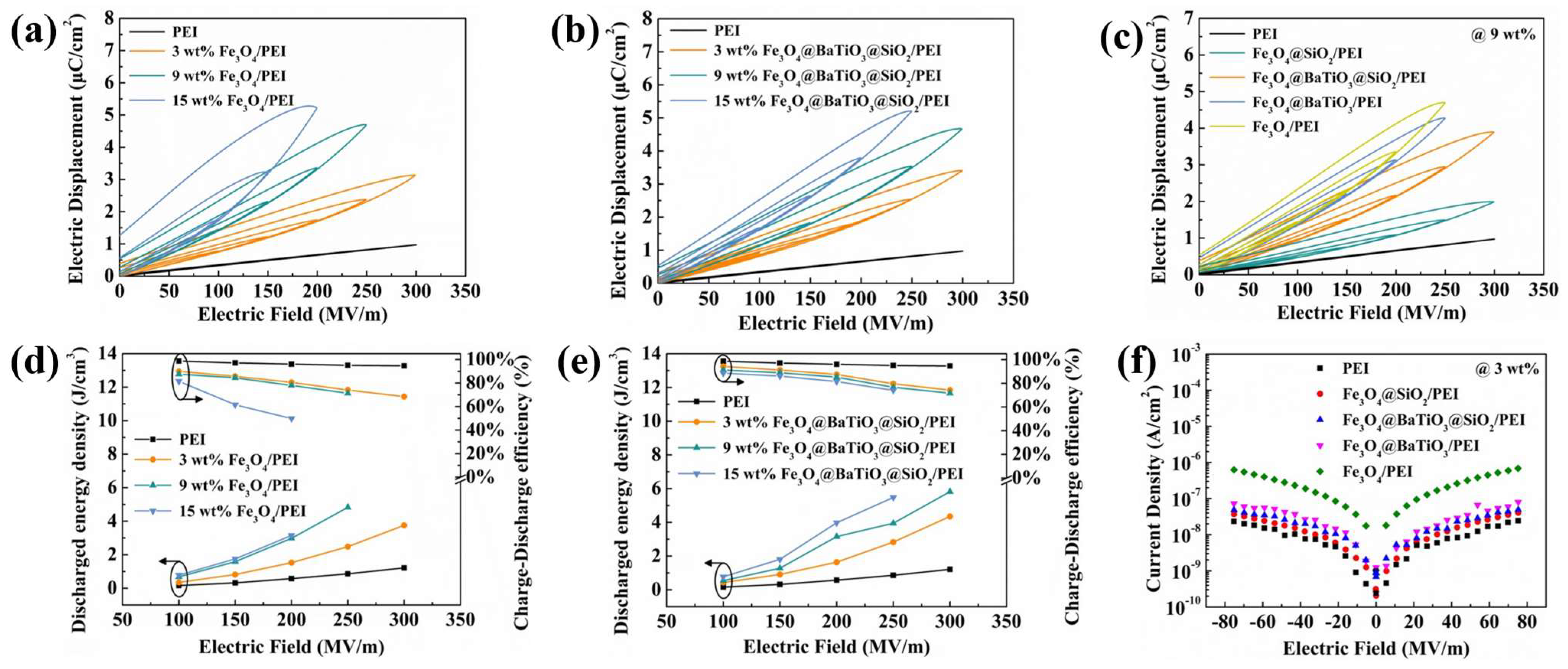Achieving Excellent Dielectric and Energy Storage Performance in Core-Double-Shell-Structured Polyetherimide Nanocomposites
Abstract
:1. Introduction
2. Materials and Methods
2.1. Synthesis of Fe3O4 with a Hydrothermal Method
2.2. Preparation of Core-Shell-Structured Fe3O4@BaTiO3 Nanospheres
2.3. Preparation of Core-Shell-Structured Fe3O4@SiO2 or Core-Double-Shell-Structured Fe3O4@BaTiO3@SiO2 Nanospheres
2.4. Preparation of PEI-Based Nanocomposite Films
2.5. Characterization
3. Results and Discussion
3.1. Preparation and Structure of the Nanoparticles
3.2. Properties of the PEI-Based Nanocomposite Films
4. Conclusions
Supplementary Materials
Author Contributions
Funding
Institutional Review Board Statement
Data Availability Statement
Conflicts of Interest
References
- Zhang, C.; Tong, X.; Liu, Z.; Zhang, Y.; Zhang, T.; Tang, C.; Liu, X.; Chi, Q. Enhancement of Energy Storage Performance of PMMA/PVDF Composites by Changing the Crystalline Phase through Heat Treatment. Polymers 2023, 15, 2486. [Google Scholar] [CrossRef]
- Liu, X.-J.; Zheng, M.-S.; Chen, G.; Dang, Z.-M.; Zha, J.-W. High-temperature polyimide dielectric materials for energy storage: Theory, design, preparation and properties. Energy Environ. Sci. 2022, 15, 56–81. [Google Scholar] [CrossRef]
- Ren, L.; Yang, L.; Zhang, S.; Li, H.; Zhou, Y.; Ai, D.; Xie, Z.; Zhao, X.; Peng, Z.; Liao, R.; et al. Largely enhanced dielectric properties of polymer composites with HfO2 nanoparticles for high-temperature film capacitors. Compos. Sci. Technol. 2021, 201, 108528. [Google Scholar] [CrossRef]
- Bouharras, F.E.; Labardi, M.; Tombari, E.; Capaccioli, S.; Raihane, M.; Ameduri, B. Dielectric Characterization of Core-Shell Structured Poly(vinylidene fluoride)-grafted-BaTiO3 Nanocomposites. Polymers 2023, 15, 595. [Google Scholar] [CrossRef] [PubMed]
- Feng, M.; Feng, Y.; Zhang, T.; Li, J.; Chen, Q.; Chi, Q.; Lei, Q. Recent Advances in Multilayer-Structure Dielectrics for Energy Storage Application. Adv. Sci. 2021, 8, 2102221. [Google Scholar] [CrossRef]
- Feng, Q.-K.; Zhong, S.-L.; Pei, J.-Y.; Zhao, Y.; Zhang, D.-L.; Liu, D.-F.; Zhang, Y.-X.; Dang, Z.-M. Recent Progress and Future Prospects on All-Organic Polymer Dielectrics for Energy Storage Capacitors. Chem. Rev. 2022, 122, 3820–3878. [Google Scholar] [CrossRef]
- Li, H.; Zhou, Y.; Liu, Y.; Li, L.; Liu, Y.; Wang, Q. Dielectric polymers for high-temperature capacitive energy storage. Chem. Soc. Rev. 2021, 50, 6369–6400. [Google Scholar] [CrossRef]
- Li, Y.; Liu, Y.; Tang, M.; Lv, J.; Chen, F.; Li, Q.; Yan, Y.; Wu, F.; Jin, L.; Liu, G. Energy storage performance of BaTiO3-based relaxor ferroelectric ceramics prepared through a two-step process. Chem. Eng. J. 2021, 419, 129673. [Google Scholar] [CrossRef]
- Lv, J.; Li, Q.; Li, Y.; Tang, M.; Jin, D.; Yan, Y.; Fan, B.; Jin, L.; Liu, G. Significantly improved energy storage performance of NBT-BT based ceramics through domain control and preparation optimization. Chem. Eng. J. 2021, 420, 129900. [Google Scholar] [CrossRef]
- Bleija, M.; Platnieks, O.; Macutkevic, J.; Banys, J.; Starkova, O.; Grase, L.; Gaidukovs, S. Poly(Butylene Succinate) Hybrid Multi-Walled Carbon Nanotube/Iron Oxide Nanocomposites: Electromagnetic Shielding and Thermal Properties. Polymers 2023, 15, 515. [Google Scholar] [CrossRef]
- Zhou, W.; Li, T.; Yuan, M.; Li, B.; Zhong, S.; Li, Z.; Liu, X.; Zhou, J.; Wang, Y.; Cai, H.; et al. Decoupling of inter-particle polarization and intra-particle polarization in core-shell structured nanocomposites towards improved dielectric performance. Energy Storage Mater. 2021, 42, 1–11. [Google Scholar] [CrossRef]
- Calvino, M.M.; Lisuzzo, L.; Cavallaro, G.; Lazzara, G.; Milioto, S. Halloysite based geopolymers filled with wax microparticles as sustainable building materials with enhanced thermo-mechanical performances. J. Environ. Chem. Eng. 2022, 10, 108594. [Google Scholar] [CrossRef]
- Guo, R.; Luo, H.; Yan, M.; Zhou, X.; Zhou, K.; Zhang, D. Significantly enhanced breakdown strength and energy density in sandwich-structured nanocomposites with low-level BaTiO3 nanowires. Nano Energy 2021, 79, 105412. [Google Scholar] [CrossRef]
- Liao, P.; Ye, H.; Xu, L. Improved interfacial polarization of poly(vinylidene fluoride-chlorotrifluoroethylene) composite with BaTiO3@polyaniline core-shell fiber. J. Appl. Polym. Sci. 2023, 140, e54211. [Google Scholar] [CrossRef]
- Chen, J.; Zhang, X.; Yang, X.; Li, C.; Wang, Y.; Chen, W. High Breakdown Strength and Energy Storage Density in Aligned SrTiO3@SiO2 Core-Shell Platelets Incorporated Polymer Composites. Membranes 2021, 11, 756. [Google Scholar] [CrossRef]
- Cheng, L.; Liu, K.; Gao, H.; Fan, Z.; Takesue, N.; Deng, H.; Zhang, H.; Hu, Y.; Tan, H.; Yan, Z.; et al. Energy storage performance of sandwich structure composites with strawberry-like Ag@SrTiO3 nanofillers. Chem. Eng. J. 2022, 435, 135064. [Google Scholar] [CrossRef]
- Zhang, R.; Sheng, Q.; Ye, L.; Long, S.; Zhou, B.; Wen, F.; Yang, J.; Wang, G.; Bai, W. Two-dimensional SrTiO3 platelets induced the improvement of energy storage performance in polymer composite films at low electric fields. Ceram. Int. 2022, 48, 7145–7152. [Google Scholar] [CrossRef]
- Yin, L.; Wang, Q.; Zhao, H.; Bai, J. Improved Energy Density Obtained in Trilayered Poly(vinylidene fluoride)-Based Composites by Introducing Two-Dimensional BN and TiO2 Nanosheets. ACS Appl. Mater. Interfaces 2023, 15, 16079–16089. [Google Scholar] [CrossRef]
- Wang, Q.; Zhao, H.; Yin, L.; Ding, X.; Wei, X.; Bai, J. Improved Energy Storage Performance in Sandwiched Poly(vinylidene fluoride)-Based Composites Assembling with In- Plane-Oriented BN Nanosheets and TiO2 Nanowires. ACS Appl. Energy Mater. 2022, 5, 15948–15958. [Google Scholar] [CrossRef]
- Chi, Q.; Wang, X.; Zhang, C.; Chen, Q.; Chen, M.; Zhang, T.; Gao, L.; Zhang, Y.; Cui, Y.; Wang, X.; et al. High Energy Storage Density for Poly(vinylidene fluoride) Composites by Introduced Core-Shell CaCu3Ti4O12@Al2O3 Nanofibers. ACS Sustain. Chem. Eng. 2018, 6, 8641–8649. [Google Scholar] [CrossRef]
- Kaur, S.; Singh, D.P. On the structural, dielectric and energy storage behaviour of PVDF-CaCu3Ti4O12 nanocomposite films. Mater. Chem. Phys. 2020, 239, 122301. [Google Scholar] [CrossRef]
- Fang, X.; Wang, S.; Li, Y.; Liu, X.; Li, X.; Lin, S.; Cui, Z.-K.; Zhuang, Q. NH2-functionalized carbon-coated Fe3O4 core-shell nanoparticles for in situ preparation of robust polyimide composite films with high dielectric constant, low dielectric loss, and high breakdown strength. RSC Adv. 2016, 6, 107533–107541. [Google Scholar] [CrossRef]
- Liu, Q.; Cheng, Z.; Qian, J.; Chen, X.; Zhang, Y.; Zhuang, Q. A core@double shell-structured PBO composite with excellent dielectric properties and high heat resistance. J. Mater. Chem. A 2019, 7, 11195–11204. [Google Scholar] [CrossRef]
- Ni, X.; Feng, H.; Li, L.; Liu, X.; Wang, T.; Cui, Z.-K.; Gu, J.; Zhuang, Q. A novel poly(p-phenylene benzobisoxazole) (PBO)-based three-phase silk-cocoon network structure nanocomposites with enhanced dielectric properties. J. Mater. Sci. Mater. Electron. 2021, 32, 7574–7586. [Google Scholar] [CrossRef]
- Yuan, Y.; Wang, X.; Liu, X.; Qian, J.; Zuo, P.; Zhuang, Q. Non-covalently modified graphene@poly(ionic liquid) nanocomposite with high-temperature resistance and enhanced dielectric properties. Compos. Pt. A-Appl. Sci. Manuf. 2022, 154, 106800. [Google Scholar] [CrossRef]
- Zhang, P.; Liu, X.; Zuo, P.; Mi, P.; Zhuang, Q. Amine-Functionalized Reduced Graphene Oxide/Polyimide Nanocomposite as a Material with High Dielectric Constant and Thermal Resistance. ACS Appl. Nano Mater. 2023, 6, 1696–1706. [Google Scholar] [CrossRef]
- Dang, Z.-M.; Zheng, M.-S.; Zha, J.-W. 1D/2D Carbon Nanomaterial-Polymer Dielectric Composites with High Permittivity for Power Energy Storage Applications. Small 2016, 12, 1688–1701. [Google Scholar] [CrossRef] [PubMed]
- Tsyganov, A.; Vikulova, M.; Artyukhov, D.; Zheleznov, D.; Gorokhovsky, A.; Gorshkov, N. Intercalation Effects on the Dielectric Properties of PVDF/Ti3C2Tx MXene Nanocomposites. Nanomaterials 2023, 13, 1337. [Google Scholar] [CrossRef] [PubMed]
- Wang, Z.; Wu, D.; Kong, M.; Li, Y.; Yi, Z. High energy storage density of conductive filler composites at low electric fields through sandwich design. J. Mater. Sci. Mater. Electron. 2023, 34, 161. [Google Scholar] [CrossRef]
- Wu, J.L.; Zhang, Y.R.; Gong, Y.Z.; Wang, K.; Chen, Y.; Song, X.P.; Lin, J.; Shen, B.Y.; He, S.J.; Bian, X.M. Analysis of the Electrical and Thermal Properties for Magnetic Fe3O4-Coated SiC-Filled Epoxy Composites. Polymers 2021, 13, 3028. [Google Scholar] [CrossRef]
- Meng, X.-S.; Zhou, Y.; Li, J.; Ye, H.; Chen, F.; Zhao, Y.; Pan, Q.; Xu, J. All-Organic PTFE Coated PVDF Composite Film Exhibiting Low Conduction Loss and High Breakdown Strength for Energy Storage Applications. Polymers 2023, 15, 1305. [Google Scholar] [CrossRef] [PubMed]
- Lisuzzo, L.; Cavallaro, G.; Parisi, F.; Milioto, S.; Fakhrullin, R.; Lazzara, G. Core/Shell Gel Beads with Embedded Halloysite Nanotubes for Controlled Drug Release. Coatings 2019, 9, 70. [Google Scholar] [CrossRef] [Green Version]
- Venkata Chalapathi, K.; Prabhakar, M.N.; Song, J.-I. Study on the Effect of Core-Shell Abaca Vascular Carriers on the Self-Healing and Mechanical Properties of Thermoset Panels. Polymers 2023, 15, 2245. [Google Scholar] [CrossRef] [PubMed]
- Bi, K.; Bi, M.; Hao, Y.; Luo, W.; Cai, Z.; Wang, X.; Huang, Y. Ultrafine core-shell BaTiO3@SiO2 structures for nanocomposite capacitors with high energy density. Nano Energy 2018, 51, 513–523. [Google Scholar] [CrossRef]
- Wang, Z.; Meng, G.; Wang, L.; Tian, L.; Chen, S.; Wu, G.; Kong, B.; Cheng, Y. Simultaneously enhanced dielectric properties and through-plane thermal conductivity of epoxy composites with alumina and boron nitride nanosheets. Sci. Rep. 2021, 11, 2495. [Google Scholar] [CrossRef]
- Wu, H.H.; Zhuo, F.; Qiao, H.; Kodumudi Venkataraman, L.; Zheng, M.; Wang, S.; Huang, H.; Li, B.; Mao, X.; Zhang, Q. Polymer-/Ceramic-based Dielectric Composites for Energy Storage and Conversion. Energy Environ. Mater. 2022, 5, 486–514. [Google Scholar] [CrossRef]
- Chen, Y.; Wang, N.; Ola, O.; Xia, Y.; Zhu, Y. Porous ceramics: Light in weight but heavy in energy and environment technologies. Mater. Sci. Eng. R-Rep. 2021, 143, 100589. [Google Scholar] [CrossRef]
- Wu, C.; Alamri, A.; Deshmukh, A.A.; Li, Z.; Islam, S.; Sotzing, G.A.; Cao, Y. A Modified Polyetherimide Film Exhibiting Greatly Suppressed Conduction for High-temperature Dielectric Energy Storage. In Proceedings of the IEEE Conference on Electrical Insulation and Dielectric Phenomena (IEEE CEIDP) 2020, East Rutherford, NJ, USA, 18–30 October 2020; pp. 1–4. [Google Scholar]
- Li, Z.; Lin, H.; Ding, S.; Ling, H.; Wang, T.; Miao, Z.; Zhang, M.; Meng, A.; Li, Q. Synthesis and enhanced electromagnetic wave absorption performances of Fe3O4@C decorated walnut shell-derived porous carbon. Carbon 2020, 167, 148–159. [Google Scholar] [CrossRef]
- Pei, W.; Shang, W.; Liang, C.; Jiang, X.; Huang, C.; Yong, Q. Using lignin as the precursor to synthesize Fe3O4@lignin composite for preparing electromagnetic wave absorbing lignin-phenol-formaldehyde adhesive. Ind. Crops Prod. 2020, 154, 112638. [Google Scholar] [CrossRef]
- Chen, L.; Li, F.; Gao, B.; Zhou, C.; Wu, J.; Deng, S.; Liu, H.; Qi, H.; Chen, J. Excellent energy storage and mechanical performance in hetero-structure BaTiO3-based relaxors. Chem. Eng. J. 2023, 452, 139222. [Google Scholar] [CrossRef]
- Wang, P.; Yu, W.; Li, G.; Meng, C.; Guo, S. Printable, flexible, breathable and sweatproof bifunctional sensors based on an all-nanofiber platform for fully decoupled pressure-temperature sensing application. Chem. Eng. J. 2023, 452, 139174. [Google Scholar] [CrossRef]
- Chen, L.; Xu, X.; Wan, L.; Zhu, G.; Li, Y.; Lu, T.; Albaqami, M.D.; Pan, L.; Yamauchi, Y. Carbon-incorporated Fe3O4 nanoflakes: High-performance faradaic materials for hybrid capacitive deionization and supercapacitors. Mater. Chem. Front. 2021, 5, 3480–3488. [Google Scholar] [CrossRef]
- Qin, H.; Liu, P.; Chen, C.; Cong, H.-P.; Yu, S.-H. A multi-responsive healable supercapacitor. Nat. Commun. 2021, 12, 4297. [Google Scholar] [CrossRef] [PubMed]
- Zhou, L.; Fu, Q.; Xue, F.; Tang, X.; Zhou, D.; Tian, Y.; Wang, G.; Wang, C.; Gou, H.; Xu, L. Multiple Interfacial Fe3O4@BaTiO3/P(VDF-HFP) Core-Shell-Matrix Films with Internal Barrier Layer Capacitor (IBLC) Effects and High Energy Storage Density. ACS Appl. Mater. Interfaces 2017, 9, 40792–40800. [Google Scholar] [CrossRef] [PubMed]
- Wang, Y.; Sun, B.; Hao, Z.; Zhang, J. Advances in Organic–Inorganic Hybrid Latex Particles via In Situ Emulsion Polymerization. Polymers 2023, 15, 2995. [Google Scholar] [CrossRef]
- ASTM D149-20; Standard Test Method for Dielectric Breakdown Voltage and Dielectric Strength of Solid Electrical Insulating Materials at Commercial Power Frequencies. ASTM International: West Conshohocken, PA, USA, 2020.
- Zhang, C.; Chi, Q.; Dong, J.; Cui, Y.; Wang, X.; Liu, L.; Lei, Q. Enhanced dielectric properties of poly(vinylidene fluoride) composites filled with nano iron oxide-deposited barium titanate hybrid particles. Sci. Rep. 2016, 6, 33508. [Google Scholar] [CrossRef] [Green Version]
- Ni, X.; Wang, X.; Lin, J.; Liu, X.; Cui, Z.-K.; Zuo, P.; Zhuang, Q. Ultra-low dielectric loss and high thermal stability achieved by hierarchical microcapacitor structure in nanocomposites via surface topological modulation. Mater. Today Energy 2023, 31, 101221. [Google Scholar] [CrossRef]
- Wang, H.; Fu, Q.; Luo, J.; Zhao, D.; Luo, L.; Li, W. Three-phase Fe3O4/MWNT/PVDF nanocomposites with high dielectric constant for embedded capacitor. Appl. Phys. Lett. 2017, 110, 242902. [Google Scholar] [CrossRef]








Disclaimer/Publisher’s Note: The statements, opinions and data contained in all publications are solely those of the individual author(s) and contributor(s) and not of MDPI and/or the editor(s). MDPI and/or the editor(s) disclaim responsibility for any injury to people or property resulting from any ideas, methods, instructions or products referred to in the content. |
© 2023 by the authors. Licensee MDPI, Basel, Switzerland. This article is an open access article distributed under the terms and conditions of the Creative Commons Attribution (CC BY) license (https://creativecommons.org/licenses/by/4.0/).
Share and Cite
Yuan, Y.; Lin, J.; Wang, X.; Qian, J.; Zuo, P.; Zhuang, Q. Achieving Excellent Dielectric and Energy Storage Performance in Core-Double-Shell-Structured Polyetherimide Nanocomposites. Polymers 2023, 15, 3088. https://doi.org/10.3390/polym15143088
Yuan Y, Lin J, Wang X, Qian J, Zuo P, Zhuang Q. Achieving Excellent Dielectric and Energy Storage Performance in Core-Double-Shell-Structured Polyetherimide Nanocomposites. Polymers. 2023; 15(14):3088. https://doi.org/10.3390/polym15143088
Chicago/Turabian StyleYuan, You, Jingyu Lin, Xinhua Wang, Jun Qian, Peiyuan Zuo, and Qixin Zhuang. 2023. "Achieving Excellent Dielectric and Energy Storage Performance in Core-Double-Shell-Structured Polyetherimide Nanocomposites" Polymers 15, no. 14: 3088. https://doi.org/10.3390/polym15143088
APA StyleYuan, Y., Lin, J., Wang, X., Qian, J., Zuo, P., & Zhuang, Q. (2023). Achieving Excellent Dielectric and Energy Storage Performance in Core-Double-Shell-Structured Polyetherimide Nanocomposites. Polymers, 15(14), 3088. https://doi.org/10.3390/polym15143088




